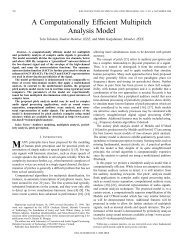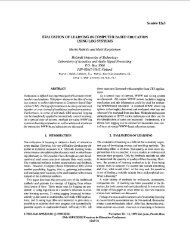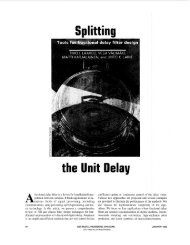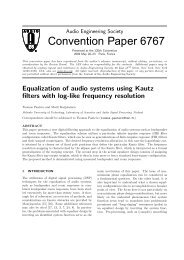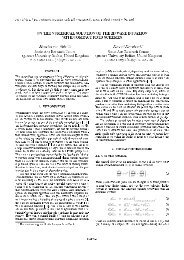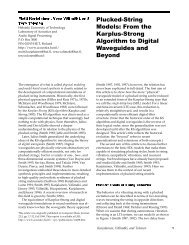Physical Modeling of Plucked String Instruments with Application to ...
Physical Modeling of Plucked String Instruments with Application to ...
Physical Modeling of Plucked String Instruments with Application to ...
You also want an ePaper? Increase the reach of your titles
YUMPU automatically turns print PDFs into web optimized ePapers that Google loves.
VALIMAKIETAL.PAPERS3) Use the truncated signal as the excitation <strong>to</strong> the The analysis and synthesis results <strong>of</strong> the steel-stringstring model, acoustic guitar were similar <strong>to</strong> those <strong>of</strong> the nylon-string4) Run the string model using the parameters derived acoustic guitar. The use <strong>of</strong> the plectrum instead <strong>of</strong> thefrom the analysis, finger in the string excitation results in a different-sound-The original and the synthesized signals presented and ing residual signal, but the string model can be the samediscussed in this chapter are downloadable as sound files for both instruments.(AIFF, WAV, and MPEG-1 layer II formats) using theWorld Wide Web [46]. 4.2 MandolinThe analysis and resynthesis <strong>of</strong> the mandolin are illus-4.1 Guitars trated in Figs. 25 and 26. We notice that windowing and'From the analysis and synthesis results <strong>of</strong> the electric truncation <strong>of</strong> the residual signal have only minor effects,guitar shown in Figs. 23 and 24 it can be seen that the shortening the decay <strong>of</strong> the lowest body resonances. Thelength <strong>of</strong> the residual signal used in resynthesis can be resynthesized <strong>to</strong>ne in Fig. 26(b) has been calculated usingreduced <strong>to</strong> about 50 ms <strong>with</strong>out any significant loss <strong>of</strong> the first 100 ms <strong>of</strong> the residual and a single-polarizationinformation. This is due <strong>to</strong> the lack <strong>of</strong> body resonances, string model. The original mandolin signal shows a slightThe resulting sound is quite similar <strong>to</strong> that <strong>of</strong> the basic beating effect after the transient part, whereas the resynthe-KS model excited <strong>with</strong> an impulse. It is clear that in this sized <strong>to</strong>ne has an exponentially decaying behavior. It is,case physical modeling principles should be extended <strong>to</strong> however, almost impossible '<strong>to</strong> distinguish the syntheticvarious magnetic pickup combinations and amplifiers, <strong>to</strong>ne from the original one by ear. Using a dual-polarization0.5 0. -i-_o. i'ii. .-1 0.05 0.1 ' 0.15 0.2 0.25 I 0.! 0.]5 012 0.25(a)(a)0._-o,-o_i i i-10 0.05 0.1 0.15 012 0.25 0.05 0.1 0.115 012 0.25Time(s)(b)Fig. 23. (a) Electric guitar <strong>to</strong>ne. (b) Residual signal after in- Fig. 25. (a) Mandolin <strong>to</strong>ne. (b) Residual signal after inverseverse filtering, filtering.Time(s)(b)0.5 0.50 *. 0-0.5 -0.-10 0.05 ' 0i 1 0.15 ' 0' 2 0.25 '0 0.05 0.1 0.15 0.2 0.25(a)(a)I , , , , ,-0.0'5I0 . '_/i0.250 0.05 0.1 0.15 0.2 0.25 0 0.05 0.1 O.15 0.2Time(s)(b)Fig. 24. (a) Truncated residual signal. (b) Resynthesized elec- Fig. 26. (a) Truncated residual signal. (b) Resynthesized mantricguitar<strong>to</strong>ne.dolin<strong>to</strong>ne.Time(s)(b)344 J.AudioEng.Soc.,Vol.44, No.5, 1996May






